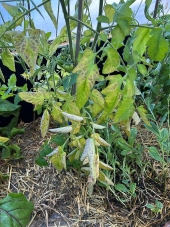



my father grew fabulous tomatoes. he used to dissolve a tbs of epsom salt in a gal. of warm water and wet the whole plant down with half of it. the rest in the soil. they usually bounced right back after that if it was a MG deficiency. it definitely cant hurt even if its not that.Joshua States wrote:
Nancy Reading wrote:It's late in the season, I suspect magnesium deficiency.
Do you intend to keep the tomatoes going much longer? A dose of Epsom salts is the quickest/available source for a pick you up. If the frosts are due soon I wouldn't (personally) bother as the plants will die then anyway.
I do plan on keeping them until they croak. We have below freezing temps every night, but the greenhouse is staying pretty warm, so the tomatoes and a couple of holdout peppers are still hanging in there.
My wife came home today with a quart bag of Epsom salt from one of her yoga students who has a fabulous garden. I'll see her tonight and ask how to apply it. If you have any suggested methods, I'm all ears.

when you live in northern Aroostook your shortest drive to anything considered a decent sized town is at least 1.5hrs which is Presque ilse which is the closest Walmart. we order most things online which saves us time and fuel.Manda Bell wrote:Hahahah. Oh wow. We never would’ve moved here (or any other nowhere for that matter) if we had to commute. The last time we moved and worked outside the house we only considered homes within a 15-minute drive of the office. It limited our choices sure but oh man it was worth it. That’s usually the most time we can stand to waste in a car. Personal preference, I guess!
Since moving here though we are slowly getting used to shopping errands taking all day (despite our best efforts.. haha) 😃 No place is perfect but so far we absolutely love it here. Right now I’m enjoying my coffee while listening to birds and rain. A bear literally just strolled past the window as I was typing! We’ve never experienced anything like this place before. I mean, this is what we moved here for! I can’t even say how much we love it. Maine had exceeded all of our expectations. It’ll be even better when my planned food forest starts really coming together.
Who knows, perhaps after a few years here a few 2-hour away adventures won’t seem so cumbersome. Maybe?!

hard to find in the U.S. very easy to grow from cuttings. stick cutting in ground were you want it in fall just before the ground freezes, leaving 1 bud above ground. bury thickly in mulch. come spring remove mulch to 1in. around cutting . almost always will grow. sometimes getting some fruit by year 2.Blake Lenoir wrote: Where could we find wild frozen currents to help our chokeberries taste better in smoothies, yoghurts and stuff?

yes. just follow any black currant jam recipe and replace half with aronia. also, aronia used with dairy will remove astringency.Blake Lenoir wrote: Could currents help sweeten the taste with chokeberry and help make the flavor less sour and tart?

try using black currants 50-50 with aronia. makes a great jam. i make freezer jams. birds dont touch aronia here. ive even left some on the bushes over winter for them. they just dried up.Nancy Reading wrote:I would say the juice is easy to make and very nutritious. A little goes a long way. It doesn't need extra sugar, it's not as astringent as the fruit, but can take a bit of diluting. Use apple juice to dilute with if you want it sweeter. The remaining pulp has lots of the nutrients in - the skins are packed with phytonutrients and can apparently be dried to make a tea.
I dried some whole berries in my lower (cool) oven. Maybe I over dried them, they are a bit crunchy now, but could probably be used in baking. The jam I made has turned out OK. Next time I will use less water and less sugar since it has turned out a bit insipid. Whilst it was cooking I took some of the jam out and used it as a sauce on our rice pudding and IT WAS DELICIOUS!!! (emphasis intended) it was quite honestly the most gorgeous tasting fruit I can remember having, like the full taste of cherries, plums, strawberries, raspberries all in one fruit. So I was a bit disappointed how bland the finished jam turned out. Obviously something is lost in the final boiling, so minimum cooking is the rule next time. Don't get me wrong, it was still a very nice jam, but not the "blow my socks off" flavour I was sort of expecting.
I may still have enough berries on the bushes to get another small batch if the birds permit, but I'm certainly going to propagate some more of my best bushes and maybe some more from seed. If I can get enough dotted round the field, maybe the birds will leave some more for me.